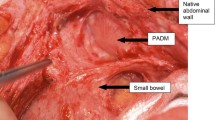Abstract
Perineal hernia following major pelvic surgery is a rare but recognised complication. Various surgical approaches to the repair of a symptomatic perineal hernia have been described. We describe the first reported use of the Mitek suture anchors to secure an acellular porcine dermal graft to the ischia during the transperineal repair of a large perineal hernia.



Similar content being viewed by others
References
Aboian E, Winter DC, Metcalf DR, Wolff BG (2006) Perineal hernia after proctectomy: prevalence, risks, and management. Dis Colon Rectum 49:1564–1568
Hullsiek HE (1956) Perineal hernia following abdominoperineal resection. Am J Surg 92:735–738
Remzi FH, Oncel M, Wu JS (2005) Meshless repair of perineal hernia after abdominoperineal resection: case report. Tech Coloproctol 9:142–144
Kathju S, Lasko LA, Medich DS (2010) Perineal hernia repair with acellular dermal graft and suture anchor fixation. Hernia 15:357–360
Stamatiou D, Skandalakis JE, Skandalakis LJ, Mirilas P (2010) Perineal hernia: surgical anatomy, embryology, and technique of repair. Am Surg 76:474–479
Berrrevoet F, Pattyn P (2005) Use of bone anchors in perineal hernia repair: a practical note. Langenbecks Arch Surg 390:255–258
Beck DE, Fazio VW, Jagelman DG, Lavery IC, McGonagle BA (1987) Postoperative perineal hernia. Dis Colon Rectum 30:21–24
So JB, Palmer MT, Shellito PC (1997) Postoperative perineal hernia. Dis Colon Rectum 40:954–957
Ghellai AM, Islam S, Stoker ME (2002) Laparoscopic repair of postoperative perineal hernia. Surg Laparosc Endosc Percutan Tech 12:119–121
Washiro M, Shimizu H, Katakura T, Kumagai S, Miyazaki M (2010) Using the uterus to close a pelvic defect after primary perineal posterior hernia repair: report of a case. Surg Today 40:277–280
Hansen MT, Bell JL, Chun JT (1997) Perineal hernia repair using gracilis myocutaneous flap. South Med J 90:75–77
Erdmann MW, Waterhouse N (1995) The transpelvic rectus abdominis flap: its use in the reconstruction of extensive perineal defects. Ann R Coll Surg Engl 77:229–232
Loganathan A, Ainslie WG, Wedgwood KR (2010) Initial evaluation of Permacol bioprosthesis for the repair of complex incisional and parastomal hernias. Surgeon 8:202–205
Conflict of interest
None.
Author information
Authors and Affiliations
Corresponding author
Rights and permissions
About this article
Cite this article
Ong, S.L., Miller, A.S. A transperineal approach to perineal hernia repair using suture anchors and acellular porcine dermal mesh. Tech Coloproctol 17, 605–607 (2013). https://doi.org/10.1007/s10151-011-0774-5
Received:
Accepted:
Published:
Issue Date:
DOI: https://doi.org/10.1007/s10151-011-0774-5




